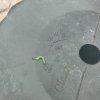DCcan
Well-Known Member
Something to note for liquid BT products, liquid formulations break down in about a year, powders will keep their potentcy for 3-4 years.
It's also most effective at 1st and 2nd instar feedings, so when they are smaller. Don't wait till you see them in other words.
Re apply after rain and at least weekly, light breaks down the proteins.
Another thing you can do is alternate or mix BT products, much greater mortality rate than a single type since they have different proteins.
Several other promising new or mixed varieties of BT are coming down the pipe. Mostly to slow the growth of resistance that's beginning to show up for BT-k.
I have a preponderence of cabbage lopers, armyworms, and diamondback moths, so BT-a has been more effective at control.
Table 1. Cry toxin profile of Bacillus thuringiensis spray products (upper table) and susceptibility of Lepidoptera species to those Cry toxins (lower table).

It's also most effective at 1st and 2nd instar feedings, so when they are smaller. Don't wait till you see them in other words.
Re apply after rain and at least weekly, light breaks down the proteins.
Another thing you can do is alternate or mix BT products, much greater mortality rate than a single type since they have different proteins.
Several other promising new or mixed varieties of BT are coming down the pipe. Mostly to slow the growth of resistance that's beginning to show up for BT-k.
I have a preponderence of cabbage lopers, armyworms, and diamondback moths, so BT-a has been more effective at control.
Table 1. Cry toxin profile of Bacillus thuringiensis spray products (upper table) and susceptibility of Lepidoptera species to those Cry toxins (lower table).

Last edited:






